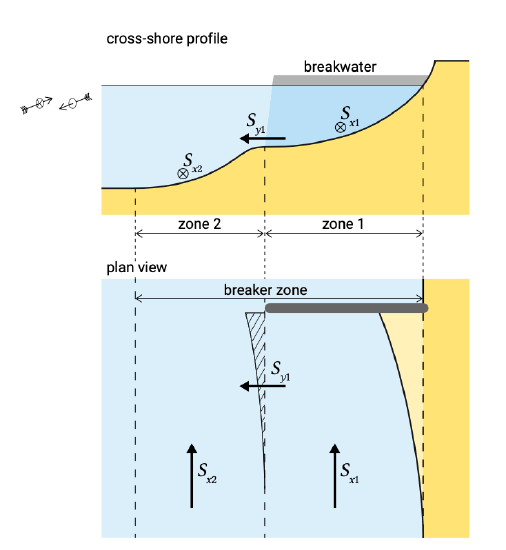8.3.4: Multiple line theory
- Page ID
- 16389
If the single line shoreline approach is considered to be over-schematised it is possible to use multiple line theory. The principles of multiple and single line theory are the same. The most significant difference is that cross-shore exchange of sediment is taken into account in multiple line theory which allows a non-equilibrium cross-section to be considered. Furthermore the shore (cross-section) can be schematised in two or more zones of the profile.

Bakker (1968) proposed a two-line approach in order to study the dynamics of a coast with a groyne system that only partially blocked the longshore transport (since they were shorter than the width of the breaker zone). He recognised the two distinct transport zones shoreward and seaward of the tip of structure and made a schematization into two zones as shown in Fig. 8.16. In some special cases he found analytical solu- tions to the two-line approach.
For each zone in a two (or more) line model, a computation of the development of one depth contour can be made, similar to the computation of the single line in the single line coastline models, but with the addition of an extra term in the continuity equation, viz. the cross-shore sediment transport component. In a schematization as in Fig. 8.16 each longshore transport component \(S_{xi}\) is directed parallel to the coast and describes the littoral sand movement in its zone. The horizontal planes, the boundaries between the zones, should in principle be selected at elevations which correspond more or less to flat portions of the total profile. If structures, such as groynes, are present, the boundaries between the zones can be chosen such that they correspond to limits of a transport zone. The longshore transport components can be determined with any longshore transport formula, except for bulk longshore transport formulation. The cross-shore sediment transport exchange can be evaluated based on deviations from an equilibrium profile (see Sect. 1.5.4 and Sect. 7.2).
In addition to the analytical models, numerical models have been developed based on an arbitrary number of lines connected by cross-shore sediment transport. As with the single line theory, a multi-line model assumes that the cross-shore and alongshore physics are decoupled. It has proven to be difficult to specify realistic formulations for both the cross-shore sediment transport and the cross-shore distribution of the longshore sediment transport. Hence, for strongly 2D coastlines a more physics based area model should be applied instead.


